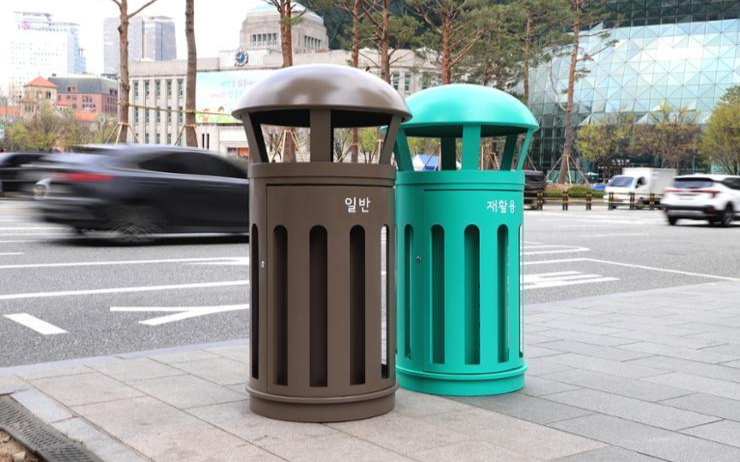Newly designed trash cans are installed on a sidewalk near City Hall in central Seoul. Courtesy of Seoul Metropolitan Government
City government hopes iconic trash cans will enhance convenience with easy waste disposal in public
By Jung Da-hyun
The Seoul Metropolitan Government announced Monday that it has installed 30 newly designed trash bins in high-traffic areas, such as near City Hall and Dongdaemun Design Plaza (DDP), to make waste disposal easier for people.
This initiative is not only about convenience but also about creating iconic elements for the city.
Seoul residents had pointed out the lack of trash cans in public as a major inconvenience. A 2021 survey conducted by the Climate and Environment Headquarters of the Seoul Metropolitan Government showed that 73.3 percent of respondents felt there were not enough trash cans in the city.
As of 2023, there were 4,956 trash cans across Seoul, according to the city government. The number is significantly down from 7,607 in 1995 when the volume-based waste fee system was first introduced.
An increasing number of people used public trash cans to dump their household garbage so they could avoid paying fees, as they had to pay for their waste disposal based on the amount they disposed of at home under the current system. Consequently, the city started removing trash cans from the streets gradually.
In addition, the existing trash cans also posed issues due to their inconspicuous colors and small slots, making it hard to find and dispose of various sizes of waste.
To tackle these problems, the city government sought designs for trash cans that would foster familiarity and give a positive image, while also addressing issues such as waste accumulation, odors and obstruction of city views.
Various designs for the new trash cans were conceptualized by citizens, environmental officials and experts to make them more appealing and recognizable.

A street cleaner checks the newly designed trash cans. Courtesy of Seoul Metropolitan Government
While designing the new trash cans, convenience and recognizability were prioritized.
Special attention was given to their shape and color, with recycling bins featuring green colors for easy identification.
Measures were also taken to enhance convenience, such as adjusting the height of the inlet to enable waste disposal without the need to bend over.
Furthermore, the trash cans have been designed with increased entrance and overall capacity to minimize the misplacement of waste. By extending slots and capacity, the city government aims to maintain cleanliness both around the trash cans and within them.
Symbolism was also one of the key considerations in the design process, with elements representing the city incorporated into the trash can design.
Two main designs were selected — one with a simple shape and another featuring Seoul’s iconic smile image.
The city government also created a specialized design that can be easily adapted to various situations by placing a customized cover on top of a standard form trash can. This allows for customization based on the specific location and purpose of installation, whether it’s in parks or at outdoor events.
The basic and specialized trash can designs, which garnered high preference among field officials and experts, were tested out in Jung District, Jongno District and Dongdaemun District.
The city government will conduct thorough evaluations of these trash cans based on factors like convenience, cleanliness and their integration with the surroundings for citizens and waste disposal workers. Any necessary design enhancements will be implemented accordingly.
Furthermore, the city government plans to expand the use of these iconic trash cans throughout Seoul.
“We expect these new trash cans to play a significant role in improving the quality of city life, considering both urban landscape and convenience,” said Choi In-gyu, chief of the Design Policy Bureau at the city government.


